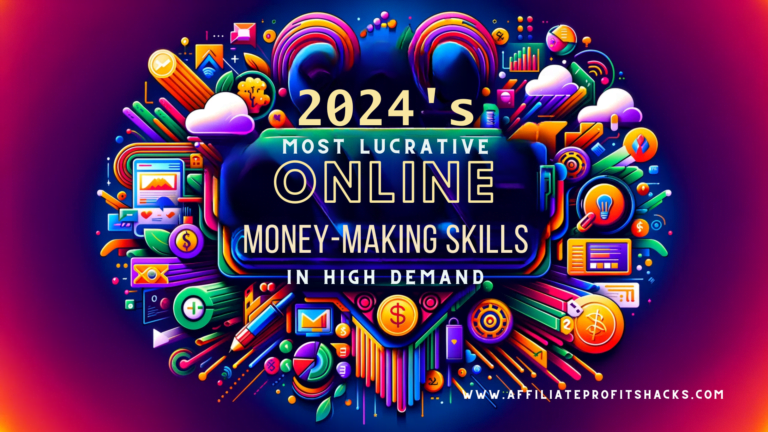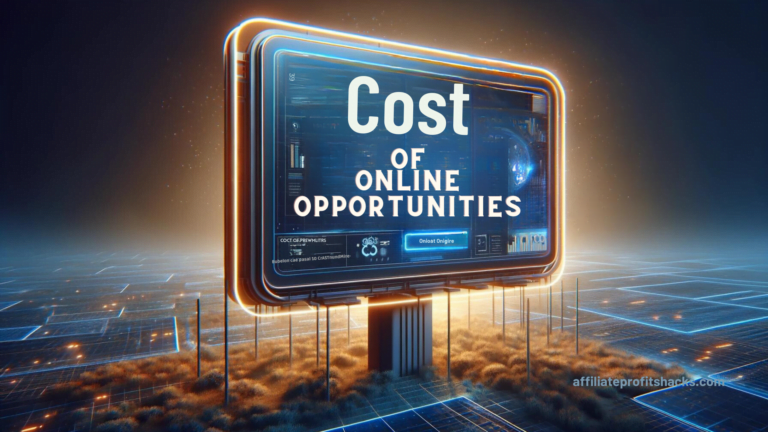Influencer Marketing: Unpacking the What, Why, and How
Welcome and thank you for checking out my comprehensive guide to Influencer Marketing.
Influencer marketing, a buzzword in today’s digital landscape, isn’t as complex as it might sound. At its core, it’s about leveraging the reach and credibility of influential people on social media to promote products, brands, or ideas. This marketing strategy has grown from a niche tactic into a cornerstone of many businesses’ digital marketing efforts. But why has it become so popular, and how exactly does it work?
Best Recommended and Proven Way to Make Money Online – Click HERE for Instant ACCESS >>

This article demystifies influencer marketing, exploring its rise, processes, benefits, challenges, and strategies for success, all in an easy-to-understand format suitable for anyone curious about this modern marketing phenomenon.
Introduction to Influencer Marketing: Defining the Concept
In the world of social media and digital marketing, influencer marketing stands out as a key player. This strategy hinges on using influential personalities to spread a brand’s message to a larger market. Unlike traditional forms of advertising, influencer marketing relies on individuals known for their expertise, popularity, or authority in specific niches. These individuals, called influencers, have the power to affect the purchasing decisions of others because of their authority, knowledge, position, or relationship with their audience.
Firstly, let’s clarify what an influencer is. An influencer can be anyone from a high-profile celebrity to a popular blogger or a respected industry expert. The common thread is their large and engaged following on social media platforms like Instagram, YouTube, Twitter, or TikTok. Their followers look to them for recommendations, reviews, and lifestyle insights.
Now, let’s delve into the concept of influencer marketing. This approach involves a brand collaborating with an online influencer to market one of its products or services. Some influencer campaigns are less tangible than that – brands simply work with influencers to improve brand recognition.
An essential aspect of influencer marketing is its reliance on the influencer’s credibility. This credibility is what sets it apart from other marketing strategies. Influencers have built a level of trust with their audience that makes their endorsements more genuine and effective compared to traditional advertising.
Moreover, influencer marketing taps into the concept of social proof, a powerful psychological phenomenon where people mimic the actions of others in an attempt to reflect correct behavior in a given situation. When influencers positively mention a product or brand, their audience is more likely to trust and purchase because someone they admire and relate to endorses it.
As we move forward, we will explore the rise of this marketing strategy, understanding why it has become increasingly popular in the digital age. We will also delve into the nuts and bolts of how it works, its benefits and challenges, and how businesses can effectively implement influencer marketing strategies.
The Rise of Influencer Marketing: Understanding its Popularity and Growth
Recently, influencer marketing has experienced a meteoric rise, becoming a key player in the marketing strategies of many brands. This surge can be attributed to several factors, which together paint a picture of why influencer marketing has become so appealing in the digital age.
Firstly, the widespread use of social media plays a pivotal role. Platforms like Instagram, YouTube, and TikTok have become integral parts of daily life for millions. With the rise of these platforms, influencers have gained substantial followings, providing a ready audience for marketing messages. This shift in media consumption from traditional to digital platforms means that influencer marketing can often reach a larger audience than traditional media.
Secondly, the changing nature of consumer trust has influenced the rise of influencer marketing. Consumers, particularly younger generations, tend to trust influencers more than traditional advertisements or celebrity endorsements. Influencers are often perceived as more relatable and authentic, making their endorsements feel more genuine. This trust is a valuable commodity in the world of marketing.
Furthermore, the ability to target specific niches is a significant advantage. Influencers often cater to specific interests or demographics. For brands, this means being able to reach a targeted audience that is more likely to be interested in their product or service, leading to higher engagement rates than traditional broad-spectrum advertising.
Moreover, influencer marketing has proven to be cost-effective, especially for small to medium-sized businesses. While securing a top-tier influencer can be expensive, there are many micro-influencers with smaller, highly engaged audiences. These collaborations can provide a better return on investment, as these influencers often have higher engagement rates and a more loyal following.
Lastly, the measurable results of influencer marketing campaigns make them appealing to marketers. With advanced analytics tools, brands can track the performance of their influencer campaigns in real-time, adjusting strategies for maximum effectiveness.
As we continue, we will dive into the mechanics of how influencer marketing works, shedding light on the process and key elements that make it so effective.
How Influencer Marketing Works: The Process and Key Elements
Delving into how influencer marketing functions, it’s clear that this strategy is more than just finding someone with a large following to promote a product. It’s a nuanced process involving careful planning, collaboration, and execution. Here, we break down the key elements that make up the backbone of a successful influencer marketing campaign.
Identifying the Right Influencers
The first step is identifying the right influencer for your brand. This involves more than just looking at the number of followers. It’s crucial to find influencers whose followers align with your target audience. Additionally, their content style, tone, and values should resonate with your brand’s image. Tools like social listening and influencer platforms can aid in finding influencers whose audience demographics and interests match your target market.
Crafting a Collaborative Strategy
Once the right influencer is onboard, developing a collaborative strategy is vital. This includes defining campaign goals, messaging, and the type of content to be created. It’s essential for the brand and the influencer to be on the same page to ensure the campaign resonates with the audience and meets the set objectives.
Best Recommended and Proven Way to Make Money Online – Click HERE for Instant ACCESS >>
Content Creation and Promotion
The influencer then creates content that integrates the brand’s message. This could be in the form of social media posts, blogs, videos, or stories. The content should align with the influencer’s usual style to maintain authenticity.
Effective influencer marketing also involves timing. The content needs to be shared at a time when it can gain maximum visibility and engagement. Additionally, leveraging multiple platforms can amplify the reach of the campaign.
Monitoring and Measuring Success
Monitoring the campaign as it unfolds is crucial. This involves tracking engagement metrics like likes, comments, shares, and, most importantly, conversions or leads generated. This data helps in understanding the campaign’s effectiveness and provides insights for future campaigns.
Building Long-Term Relationships
Lastly, successful influencer marketing often hinges on building long-term relationships with influencers. This leads to ongoing partnerships, where influencers become brand advocates over time. Such relationships can yield more authentic and impactful promotions.
In the following sections, we’ll explore the benefits and challenges of influencer marketing, offering a balanced perspective on its effectiveness. We’ll also provide actionable tips for businesses looking to harness the power of influencer marketing.
Benefits and Challenges of Influencer Marketing: A Balanced View
Influencer marketing, like any strategy, comes with its own set of benefits and challenges. Understanding these can help businesses make informed decisions about incorporating this approach into their marketing mix.
Advantages of Influencer Marketing
One of the most significant advantages is the ability to reach a specific target audience. Influencers cater to niche markets, allowing brands to directly engage with a demographic that is more likely to be interested in their products or services. This specificity can lead to higher engagement and conversion rates compared to traditional advertising.
Another benefit is the authenticity that influencers bring. Their followers often perceive them as trusted peers rather than advertisers, making their endorsements more persuasive. This trust can translate into increased brand loyalty and customer retention.
Moreover, influencer marketing can be cost-effective, particularly when partnering with micro-influencers. These influencers can often engage audiences more deeply than celebrities or mega-influencers, providing a better return on investment.
Additionally, influencer marketing content can typically be repurposed across various platforms and marketing materials, providing additional value beyond the initial campaign.
Challenges of Influencer Marketing
However, there are challenges to consider. Finding the right influencer can be a time-consuming process. It’s crucial to partner with influencers whose audience, values, and content align with your brand.
Another challenge is the potential for diminished authenticity if an influencer promotes too many products or if the partnership seems forced. It’s essential to maintain a balance to avoid audience skepticism.
Measuring the ROI of influencer marketing campaigns can also be complex. While engagement metrics are readily available, tying them directly to sales or conversions can be challenging without the proper tools and strategies.
Lastly, the ever-changing landscape of social media means that strategies need to be flexible and adaptable. What works today might not work tomorrow, so staying informed and agile is crucial.
As we move forward, we’ll delve into effective strategies for influencer marketing, providing tips for businesses looking to leverage this powerful marketing tool successfully.
Effective Strategies in Influencer Marketing: Tips for Success
To harness the full potential of influencer marketing, it’s crucial to implement strategies that are not only effective but also adaptable to the changing digital landscape. Here are some key tips to help businesses achieve success with their influencer marketing campaigns.
Establish Clear Objectives
Begin by setting clear, measurable objectives for your influencer marketing campaign. Whether it’s increasing brand awareness, driving sales, or launching a new product, having specific goals helps in tailoring the campaign and measuring its success.
Choose the Right Influencers
Select influencers who align with your brand’s values and have an audience that matches your target demographic. Look beyond follower count; consider engagement rates, content quality, and audience demographics. Utilizing tools for influencer analytics can aid in making informed decisions.
Foster Authentic Partnerships
Develop genuine, long-term relationships with influencers. Authentic partnerships lead to more natural, convincing endorsements. Encourage influencers to create content that resonates with their style and audience, as this authenticity drives engagement.
Leverage Diverse Content Formats
Utilize various content formats. Influencers can create blog posts, social media posts, videos, stories, and live streams. Diverse content types can appeal to different audience preferences, increasing the campaign’s overall reach and impact.
Monitor and Analyze Performance
Regularly monitor the campaign and analyze its performance against your objectives. Use social media analytics tools to track engagement metrics like likes, comments, shares, and conversion rates. This data is invaluable for understanding what works and making necessary adjustments.
Stay Up-to-Date with Trends
Stay informed about the latest trends in social media and influencer marketing. The digital landscape evolves rapidly, and keeping up-to-date ensures your strategies remain relevant and effective.
Be Transparent and Comply with Regulations
Ensure transparency in all influencer marketing campaigns. Influencers should disclose their partnerships with brands in accordance with FTC guidelines. Transparency builds trust with audiences and maintains your brand’s credibility.
Best Recommended and Proven Way to Make Money Online – Click HERE for Instant ACCESS >>
By following these strategies, businesses can create influencer marketing campaigns that are not only effective but also resonate with their target audiences, building long-lasting relationships and driving success.
Conclusion: Embracing the Power of Influencer Marketing
In conclusion, influencer marketing represents a dynamic and potent tool in the modern marketer’s arsenal. By understanding its nuances, embracing its benefits, and navigating its challenges, businesses can leverage this approach to significantly enhance their marketing efforts.
Recalling our journey, we started by defining influencer marketing, exploring its rise and understanding the key elements that make it work. We acknowledged the benefits, such as targeted reach, authenticity, and cost-effectiveness, while also considering the challenges like finding the right influencers and measuring ROI.
The strategies discussed, from establishing clear objectives and choosing the appropriate influencers to fostering authentic partnerships and staying up-to-date with trends, provide a roadmap for successful influencer marketing campaigns. These strategies are not just steps but an ongoing process of learning, adapting, and evolving with the digital landscape.
As the world of social media continues to grow and evolve, influencer marketing remains a vital, ever-changing field. By staying informed, flexible, and genuine, brands can harness the power of influencer endorsements to connect with audiences in meaningful, impactful ways.
Influencer marketing is more than just a marketing tactic; it’s a reflection of the changing dynamics of consumer trust and communication in the digital age. By embracing this approach with thoughtful strategies and genuine collaborations, businesses can unlock new avenues for growth and connection in an increasingly digital world.
Thank you for taking the time to read my article “Influencer Marketing: Unpacking the What, Why, and How”. I hope that you found value in it!
Best Recommended and Proven Way to Make Money Online – Click HERE for Instant ACCESS >>
You might find this related article about Maximizing Affiliate Marketing Success interesting.







